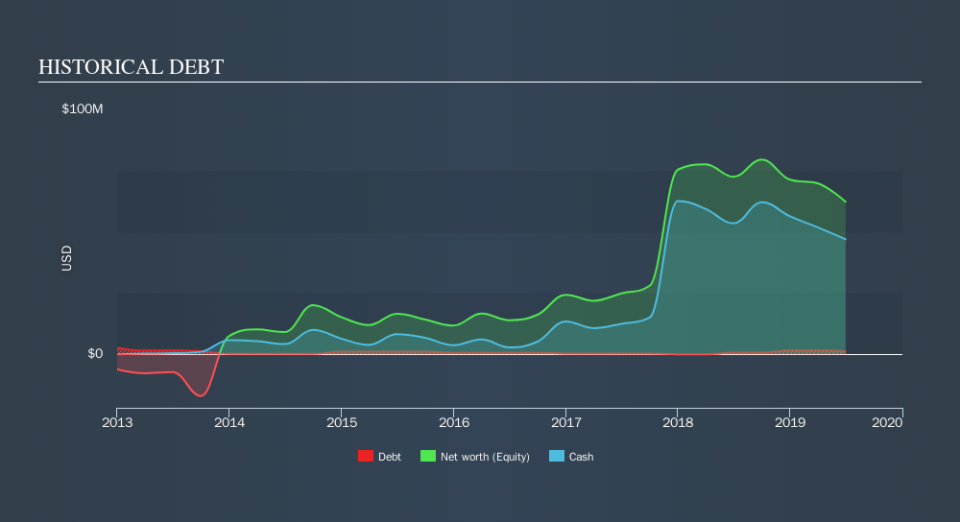Does 22nd Century Group (NYSEMKT:XXII) Have A Healthy Balance Sheet?

David Iben put it well when he said, 'Volatility is not a risk we care about. What we care about is avoiding the permanent loss of capital. So it might be obvious that you need to consider debt, when you think about how risky any given stock is, because too much debt can sink a company. As with many other companies 22nd Century Group, Inc. (NYSEMKT:XXII) makes use of debt. But should shareholders be worried about its use of debt?
When Is Debt A Problem?
Debt is a tool to help businesses grow, but if a business is incapable of paying off its lenders, then it exists at their mercy. Part and parcel of capitalism is the process of 'creative destruction' where failed businesses are mercilessly liquidated by their bankers. However, a more common (but still painful) scenario is that it has to raise new equity capital at a low price, thus permanently diluting shareholders. Of course, plenty of companies use debt to fund growth, without any negative consequences. The first thing to do when considering how much debt a business uses is to look at its cash and debt together.
Check out our latest analysis for 22nd Century Group
What Is 22nd Century Group's Net Debt?
You can click the graphic below for the historical numbers, but it shows that as of June 2019 22nd Century Group had US$1.16m of debt, an increase on US$675.2k, over one year. However, it does have US$47.0m in cash offsetting this, leading to net cash of US$45.8m.
How Strong Is 22nd Century Group's Balance Sheet?
Zooming in on the latest balance sheet data, we can see that 22nd Century Group had liabilities of US$7.18m due within 12 months and liabilities of US$1.05m due beyond that. Offsetting this, it had US$47.0m in cash and US$910.7k in receivables that were due within 12 months. So it can boast US$39.6m more liquid assets than total liabilities.
This surplus suggests that 22nd Century Group has a conservative balance sheet, and could probably eliminate its debt without much difficulty. Simply put, the fact that 22nd Century Group has more cash than debt is arguably a good indication that it can manage its debt safely. The balance sheet is clearly the area to focus on when you are analysing debt. But ultimately the future profitability of the business will decide if 22nd Century Group can strengthen its balance sheet over time. So if you're focused on the future you can check out this free report showing analyst profit forecasts.
In the last year 22nd Century Group wasn't profitable at an EBIT level, but managed to grow its revenue by8.5%, to US$26m. We usually like to see faster growth from unprofitable companies, but each to their own.
So How Risky Is 22nd Century Group?
By their very nature companies that are losing money are more risky than those with a long history of profitability. And in the last year 22nd Century Group had negative earnings before interest and tax (EBIT), truth be told. And over the same period it saw negative free cash outflow of US$20m and booked a US$13m accounting loss. However, it has net cash of US$45.8m, so it has a bit of time before it will need more capital. Overall, its balance sheet doesn't seem overly risky, at the moment, but we're always cautious until we see the positive free cash flow. When I consider a company to be a bit risky, I think it is responsible to check out whether insiders have been reporting any share sales. Luckily, you can click here ito see our graphic depicting 22nd Century Group insider transactions.
If you're interested in investing in businesses that can grow profits without the burden of debt, then check out this free list of growing businesses that have net cash on the balance sheet.
We aim to bring you long-term focused research analysis driven by fundamental data. Note that our analysis may not factor in the latest price-sensitive company announcements or qualitative material.
If you spot an error that warrants correction, please contact the editor at editorial-team@simplywallst.com. This article by Simply Wall St is general in nature. It does not constitute a recommendation to buy or sell any stock, and does not take account of your objectives, or your financial situation. Simply Wall St has no position in the stocks mentioned. Thank you for reading.

 Yahoo Finance
Yahoo Finance 
